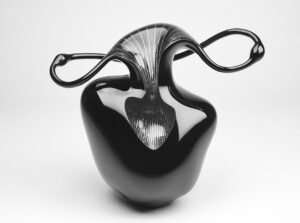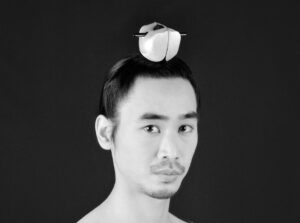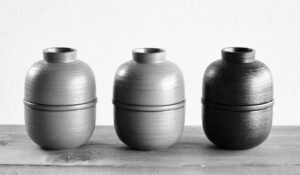Panel Discussion

Comments on the Jurors’ Special Prize Winners(3/3)
TAMAYA (MC) ───── Thank you. Next, the Nobuyuki Tanaka Prize winner, “Infinite Reincarnation – Uterus I” by ZHANG Siyi will be introduced by Professor TANAKA.

夢幻の輪廻-孕 Ⅰ
Infinite Reincarnation -Uterus Ⅰ
W60 × D40 × H60
2022
張 思藝
ZHANG, Siyi (Japan)
TANAKA ───── The expression of urushi is quite precise and fine. This exhibition has selected beautiful works based on tradition that promote the daily use of lacquer, but although I wouldn’t call it a movement, artistic expression using lacquer is quite significant. I think there are a lot of things going on right now.
ZHANG is an exchange student from China. This may sound a little abstract, but in a way, our internal organs are connected to our sense of the universe. In fact, we humans are connected with nature, the earth, and to the universe. In ancient China, people had similar thoughts. This is a work that expresses this philosophy through urushi represented by internal organs.
In the traditional Japanese way of life, a beautiful culture has developed. However, based on Japanese culture, how can we who are now living our lives, express our hearts, spirit and thoughts through the use of urushi? The question is whether and how we can incorporate it. Urushi has the potential for new creativity. From this perspective, I hope the submissions which were not selected as prize-winners will be well displayed at the Ishikawa International Urushi Exhibition 2023. Since this is a competition as well as an exhibition, the process of evaluating and judging is unavoidable. However, I deliberately recommended this work for an award because it incorporates new ideas and ways of thinking about lacquer.
TAMAYA (MC) ───── Thank you. Next, we would like Shinya Yamamura to make some comments on the Shinya Yamamura Prize winner “Sangtu” by Marion DELARUE.

山村慎哉賞
Sangtu
W10 × D6 × H6
2020
DELARUE, Marion (France)
Shinya YAMAMURA ───── I had difficulty in deciding on the Shinya Yamamura Prize winner. I did not know what Sangtu was. I learned that Sangtu is a traditional Korean topknot ornament for men. While watching Korean historic dramas you will come across Korean aristocrats tying their hair in a topknot and covering the knot with a shell ornament and urushi pin.
Without knowing the work in detail, I was attracted to it because I am also an urushi artist and I am interested in materials. I have never seen anything like the shape of this shell. Later, I found that the shell is a nautilus. However, I still did not understand how the sides, front and back parts were attached to each other. I had been curious about the connection for a long time. I did some research and found that shell shapes are usually hollow from the entrance to the end, but in the case of the nautilus’ spiral shape, in the middle of the shell there are several layers which are divided into chambers. Rather than using that divided first layer to attach it later, the artist carves out the shape of the material itself to express it.
Crafts are inevitably a world of materials and techniques. I think it has aspects that are different from other forms of art, such as how to think about it and make it look beautiful. In that sense, when you usually think of raden (mother-of-pearl inlay), it’s made by removing a thin layer from a shell and applying it piece by piece to lacquerware. However, for this work, the technique is quite different – it skillfully utilizes the form of the shell itself. Because of how skillful and unique this work is, I selected it as the Shinya Yamamura Prize winner.
However, there is a little more thought behind this too. The author is a French woman, and she feels that this shape is very feminine. By using a feminine symbol in Korea’s male-dominated and authoritative society, it brings some humor to the object. I chose this work not only because of the interesting materials, but also because it included the thoughts of the artist herself.
TAMAYA (MC) ───── Thank you. Last but not least, the Masahito Shiho Prize winner “Makijinuri Lunch Box” by Minako HAYAKAWA and Tomohiro HAYAKAWA.

志甫 雅人 賞
蒔地塗 Lunch Box
Makijinuri Lunch Box
W11.1 × D11.1 × H14(各)
2017
彩木工房まるもん屋
早川 美菜子 / 早川 朋宏
Saimoku Kobo Marumonya
HAYAKAWA, Minako
HAYAKAWA, Tomohiro (Japan)
SHIHO ───── This year, as you can see, there was a great variety of entries and prize-winning works, and I believe that they were created and evaluated from a variety of perspectives. Finally, the Shiho Prize goes to these colorful lunch boxes that propose an enjoyable lunchtime. The box has three layers where you can place rice in the bottom, side dishes in the middle, and a lid on top. The idea is that you can turn over the lid to use for miso soup. You can almost hear ‘bon appétit!’
The submitted photograph showed the lunchbox in three colors, but the product was sent to the Secretariat in seven colors. As the title explains, it is made with a makiji technique, making the products durable and crack-resistant so that people can use the lunch boxes every day and not only for special occasions. The intention seems to be for people to use lacquerware more often and to feel familiar with it. The two artists trained at the Ishikawa Prefectural Training Institute of Wood Turning, and are now running a workshop in Yamagata.
When I looked at the actual product, I could see that using a colorful and nicely-shaped lunch box would definitely make lunchtime more enjoyable every day, so I chose it for the award. This was actually voted on by several jurors, so I think it probably resonated with them too.
This Urushi Exhibition has been held for a long time and this is the 13th event. The Secretariat hopes we will continue to collect a variety of works including such enjoyable works as these, so we hope you will continue to take part in the exhibition.
